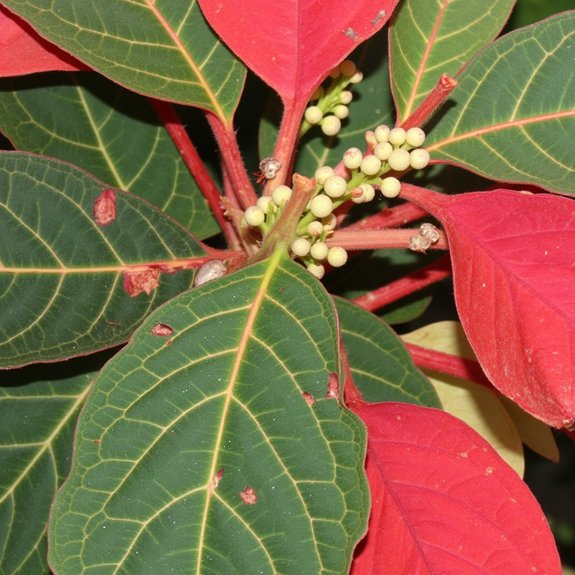Your once-vibrant poinsettia’s yellowing leaves are like warning flags, signaling that something’s gone wrong in its carefully balanced world. When you notice those cheerful red bracts starting to fade and green foliage turning an alarming shade of yellow, you’re looking at a plant under serious stress. The culprit could be anything from temperature swings to watering mistakes, but here’s the catch: identifying the exact cause requires detective work.
Contents
Temperature Stress and Environmental Instability

While poinsettias bring festive cheer to your home, they’re surprisingly finicky about temperature changes. These tropical natives crave consistent warmth between 65-75°F, making temperature regulation essential for healthy foliage.
Environmental factors like drafty doorways, heating vents, and fireplaces create stress that triggers yellowing leaves. You’ll notice the damage within days of exposure to fluctuating temperatures.
Keep your poinsettia away from high-traffic areas where doors open frequently. Avoid placing it near heat sources that create hot spots during the day, then cool dramatically at night.
Once you’ve found the perfect spot, resist moving your plant around – stability prevents temperature shock.
Watering Problems and Drainage Issues
Poor drainage creates the most common watering disasters for poinsettias, turning holiday joy into yellowing disappointment. Those decorative foil sleeves look festive, but they’re plant killers. Remove them immediately, or punch drainage holes to prevent water accumulation.
Check soil moisture by pushing your finger three inches deep into the potting mix. If it’s dry, water thoroughly until excess drains completely. Never let your poinsettia sit in standing water.
Both overwatering and underwatering cause leaf yellowing, so consistency matters. Implement proper drainage solutions by ensuring pots have adequate holes, and always empty saucers after watering sessions.
Inadequate or Excessive Light Exposure

Since poinsettias demand 6-8 hours of bright, indirect sunlight daily, incorrect light exposure triggers yellowing leaves faster than most other care mistakes. You’ll notice scorched, brown-edged leaves when light intensity becomes too harsh from direct sun exposure. Position your plant near south-west or east-facing windows for ideal conditions.
Insufficient light duration causes pale, wilting foliage that gradually yellows from the bottom up. If natural sunlight isn’t adequate, you’ll need artificial grow lights to supplement the required daily exposure. Remember, these photoperiodic plants also need extended darkness periods to maintain their vibrant holiday colors.
Over-fertilization causes more leaf yellowing damage than most poinsettia owners realize, especially when you feed the plant during its colorful holiday phase. Your poinsettia’s focusing all its energy on maintaining those vibrant bracts, not growing new foliage.
Fertilizer timing matters tremendously. Stop feeding once color changes begin appearing on your plant. Continuing fertilization creates nutrient overload, leading to bract necrosis and unsightly edge burn on leaves.
Proper nutrient balance means avoiding any fertilizer during the holiday display period. Your plant’s already invested in color production, and additional nutrients will disrupt this delicate process, causing yellowing and premature leaf drop.
Pest Invasions and Infestations

While nutrient problems create their own headaches, tiny invaders can turn your beautiful poinsettia into a yellowing mess even faster. You’ll need solid pest identification techniques to spot trouble early. Check leaf undersides weekly for aphids, mealybugs, and spider mites—these sneaky culprits cause serious discoloration.
Fungus gnats love moist soil, feeding on roots while causing yellowing from below. Let soil dry between waterings to discourage them. Effective pest prevention strategies include quarantining new plants and using sticky yellow traps indoors.
Treat infestations immediately with insecticidal soap or neem oil, ensuring you coat all affected areas thoroughly.
Fungal Diseases and Root Problems
Even more devastating than surface pests, fungal diseases and root problems attack your poinsettia from below, creating yellow leaves that signal serious underground trouble. Root rot develops when soggy soil prevents oxygen from reaching roots, causing them to decay and turn black or brown.
Fungal infections thrive in overly moist conditions, spreading through contaminated soil or water. You’ll notice yellowing starts from lower leaves, progressing upward as roots fail. Check drainage immediately—remove dead roots, repot in fresh soil, and adjust watering habits to prevent recurrence.
Natural Dormancy Cycles and Seasonal Changes
Sometimes what looks like a disease problem is actually your poinsettia following its natural rhythm. After 5-8 weeks of vibrant color, your plant naturally enters dormancy, causing yellowing leaves and dropping foliage. This isn’t failure—it’s biology.
Early varieties might lose their punch by Christmas, while others maintain color longer. Understanding dormancy effects helps you provide appropriate seasonal care during this change.
Don’t panic when leaves yellow after the holidays. Your poinsettia’s simply preparing for its rest period. With proper seasonal care adjustments, you can guide it through dormancy and potentially enjoy another colorful display next year.
